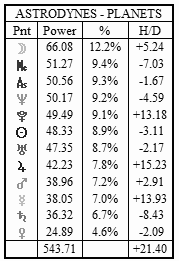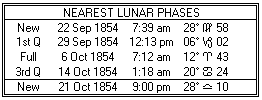Planets
Points List – Flexible

This object lists data for each displayed point of a chart. Individual columns may be switched on or off, and their ordering changed by choosing the Edit / Flexible List Columns menu item when this object is selected. The columns available are:
•Pt - Point’s glyph or symbol
•Abbr - Point’s abbreviation
•Name - Point’s full name
•Longitude (Mins) - Zodiacal longitude, given to minutes of arc
•Longitude (Secs) - Zodiacal longitude, given to seconds of arc
•Longitude (Mins) & Retro. - Zodiacal longitude and retrograde symbol, given to second of arc for Sun, Moon and chart angles, and to minute of arc for other points, along with a retrograde flag if required.
•Longitude (Secs) & Retro – same as above, but values given to second of arc for all points.
•Travel - Daily travel in longitude (to mins arc if speed 1 deg/day or more, or to secs arc if less then 1 deg/day)
•Relative Speed - percentage of typical speed
•Fast/Station/Slow - Shows "Station" if within orb of a station, otherwise "Fast", "Slow" or "Retro" if it is faster than, slower than typical speed, or retrograde, respectively.
•Time Since Last Station - Time elapsed since last station
•Time To Next Station - Time to go until next station
•Position of Last Station - Zodiacal position of last station
•Position of Next Station - Zodiacal position of next station
•Distance From Last Station - Zodiacal distance from last station
•Distance To Next Station - Zodiacal distance to next station
•Latitude (Mins) - Zodiacal latitude, given to minutes of arc
•Latitude (Secs) - Zodiacal latitude, given to seconds of arc
•Right Ascension (Mins) - Right ascension, given to minutes of arc
•Right Ascension (Secs) - Right ascension, given to seconds of arc
•Declination (Mins) - Declination, given to minutes of arc
•Declination (Secs) - Declination, given to seconds of arc
•Azi. - Local azimuth (0 Degrees is North, 90 is East)
•Alt. - Local altitude (+ve above horizon, -ve below)
•Sg - Sign placement
•Hs - House placement
•Rules - Houses ruled by this point
•Disp - Dispositor of this point
•Hs (Disp) - House placement of dispositor
•Modulus - Longitude using specified modulus
•NNode - Longitude of point’s north node
•NNTrav - Daily travel of north node
•SNode - Longitude of point’s north node
•SNTrav - Daily travel of north node
•Antiscia - Longitude of point’s antiscion
•ContraAntiscia - Longitude of point’s contra-antiscion
•G.S. - Gauquelin sector of this point (36 sectors)
•G+ - Is this point in a Gauquelin plus zone (+ = yes, blank = no)
•Orb Ratios - If the current aspect set uses planet or ratios, then this shows the orb ratio in effect for this point (otherwise it shows “n/a”)
•Point’s Long Name – An extra wide column for the name (intended for use with non-standard points which have longer names such as asteroids, Arabic Parts, stars and extra ring points, for example)
•Point’s Long Abbreviation – A column with enough width for a long abbreviation – also see comments for long name
•Point’s Long Symbol – A column with enough width for multiple symbols characters – also see comments for long name
•Time of Rising, Culmination, Setting, Anti-Culm. – the local time, expressed in 24 hour format, indicating when the point crosses the local horizon or meridian. If a point does not cross the horizon during the day, then it will show times for culmination and anti-culmination, but not for rising and setting. The rising and setting times are true astronomical times rather than visual times, having no adjustment for atmospheric refraction. (Note: The rise and set times in the planetarium are visual times, and therefore differ slightly from the times given here.)
•Point’s Distance – the distance of the point from the earth (for geocentric charts) or the sun (for heliocentric charts), expressed in Astronomical Units (1 AU = average Earth/Sun distance).
•Co-Rise, Co-Culmination, Co-Set and Co-Anticulmination - the ecliptical longitude that crosses the horizon or meridian at the same time as the point does. Points that co-rise at the same ecliptical longitude are seen to rise at the same time, even though they may be at different places along the horizon, and have different zodiacal longitudes. Points that share rise, culmination, set or anti-culmination ecliptical longitudes are said to be in “paran” to one another, which is a type of mundane aspect.
•Abs (Declination) – The absolute value of declination (i.e. the angular difference from zero, ignoring its sign). This is useful as the sorting value for a tabulation in order to ensure that both parallels and contra-parallels of declination can be seen at a glance, because bodies with equal but opposite declinations have the same absolute value of declination, and appear together in such a list.
•Placidus Mundoscope – the position occupied by each point along its own diurnal arc, expressed as a pseudo-angle. 0° = Eastern Horizon, 90° = Anti-culminating, 180° = Western Horizon, 270° = Culminating. (This is similar to the Gauquelin sector measurement, except that it runs in the opposite direction and is expressed as an exact angle instead of as a sector number.)
•Prime Vertical Angle – the position occupied by each point along the prime vertical, expressed as an angle (analogous to azimuth).
•Prime Vertical Amplitude – the position occupied by each point perpendicular to the prime vertical, expressed as an angle (analogous to altitude).
•Arabic Mansion (Tropical) – The number and name of the Arabic Mansion into which each point falls, based on the tropical zodiac.
•Arabic Mansion (Sidereal) – The number and name of the Arabic Mansion into which each point falls, based on the default sidereal zodiac.
•Nakshatra – The number and name of the Nakshatra into which each point falls.
•Chinese Lunar Mansion – The number of the Chinese Lunar Mansion into which each point falls. These mansions are divisions in right ascension, the boundaries of which are defined by the positions of certain fixed stars.
Asteroid List – Flexible
Arabic Parts List – Flexible
Star List – Flexible
Extra Bodies List – Flexible
Ring Points List – Flexible
These all have the same column options as the “Points List – Flexible” object, shown above. It is recommended that the long name, abbreviation and symbol columns be used for these object rather than the standard Pt, Abbr, Name columns, in order to allow for the fact that these items have longer names than the standard chart points. Also note that not all columns will contain data when used for these types of points. For example, the Star List does not show any data in the Point’s Distance column, and shows zero values in the Travel column.
Extra Points
This shows a list of extra ring points. It has been superseded by the “Ring Points List – Flexible”, and remains only for backwards compatibility.
Astrodynes - Planets
This shows astrodyne scores for each point, giving the overall power score, the % contribution towards the total power score, and a Harmony/Disharmony score.

Nearest Eclipses

This shows a list of eclipses from 6 months before to six months after the date of the chart, showing whether they are solar or lunar, their type (partial or total), the date and time at which they occur (in the time zone of the selected chart), and their zodiacal position. The times are for either maximum eclipse or for the exact corresponding lunar phase, depending on the eclipse settings in Preferences.
Lunar Phases

This shows a list of lunar phases (new moon, 1st quarter, full moon, 3rd quarter) around the date of the chart. It lists their dates and times (in the time zone of the selected chart), the zodiacal position of the moon, and also shows an eclipse glyph if one occurs on that lunar phase. This list is expandable by changing the number of data lines. The list always contains at least one phase after the time of the chart, and up to four before the time of the chart. If the number of data lines is increased to eight or more, then the phases are split evenly between prior and subsequent lunar phases.
